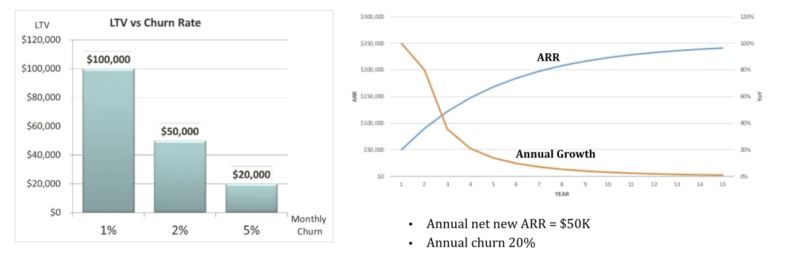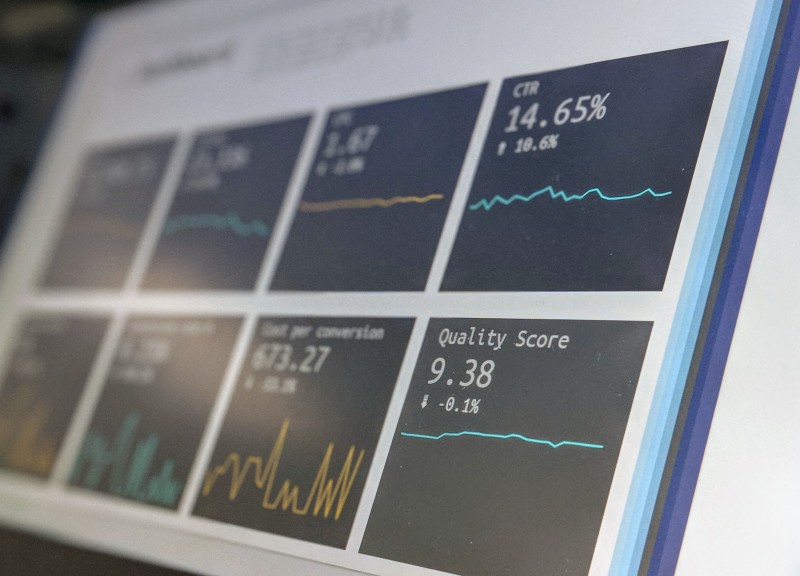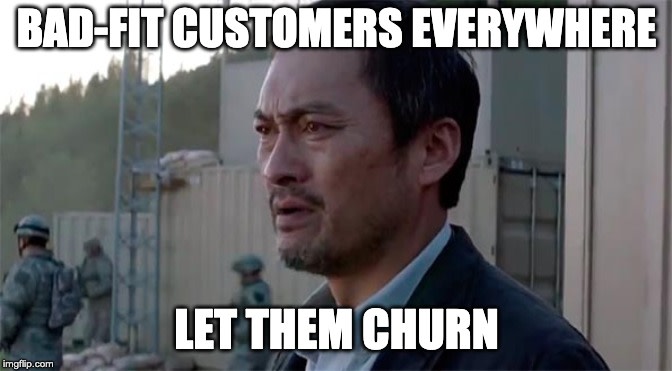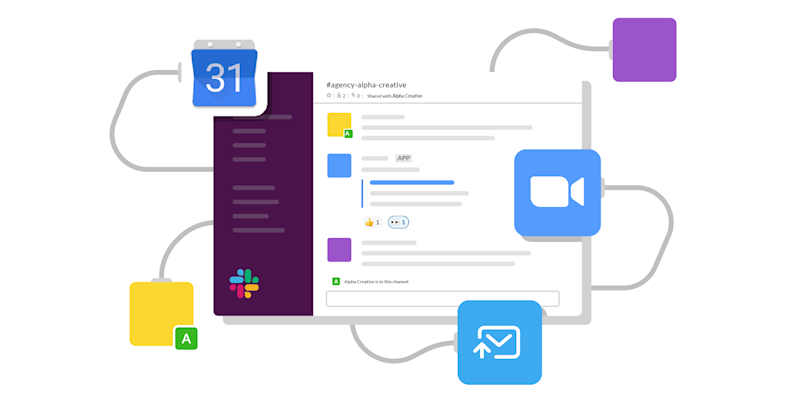
Irrespective of which stage your business is at, a lost customer is worth more than a new one.
If your business is a boat; the more customers you acquire, the bigger it gets.
Churn is like a hole in that boat—no matter the size of your boat, a huge hole in its bottom will undoubtedly challenge you to keep it afloat.
You can build the top features out there and bring in customers by the boatload, but your business will not succeed if you cannot keep them around.
And for you to do that, you need to understand churn.
“The point is, every improvement that you make to retention also improves all of these other things — virality, LTV, payback period. It is literally the foundation to all of growth, and that’s really why retention is the king.”
- Brian Balfour, VP Growth, HubSpot
Churn denotes the customers you’ve lost in a particular period of time.

With 43 different ways to calculate it, the churn rate serves as a healthy dose of reality to know what you’re doing right and not-so-right with your product.
Why is churn crucial for product managers
A product manager’s primary goal is to drive sustainable growth for their product.
In other words, increase the Lifetime Value (LTV) of the customers using your product.
If LTV is your knight in shining armor, then churn is its arch-nemesis.
Shardul, from Street Smart Product Manager, explains this well with an example:

Look at the chart on the right, for this particular company.
Even though the ARR (Average Recurring Revenue) is increasing year-on-year, the Growth is actually dipping, thanks to the high churn rate.
They’re acquiring new customers fairly well, but they aren’t staying around for long.
Now, this could happen because:
The marketing and sales teams are killing it at winning new customers.
The customer success and support teams aren’t doing a good job at retaining the customers.
The product isn’t giving the customers enough reasons to stay.
It’s every product manager’s nightmare for the third point to be the actual reason for their customers to churn.
This means that while customers are strongly resonating with the product’s value proposition and are buying the promise it makes, when they actually use it, the product fails to deliver that promise. Pushing them to churn.
Churn is a product killer, but only if you let it be one
This is the classic ‘Glass half-full or half-empty’ scenario.
Churn is inherently bad, no questioning that.
Having said that, it is also a valuable signal that can help product managers spot where they’re going wrong with their product and course-correct before the symptom blows up into a complete product failure.
Here are 3 possible underlying issues with your product that your churn rate might be trying to tell you and what you can do about it:
1. Your product-market fit is, well unfit
Are you attracting the wrong set of customers to your product?

They could be:
Customers whose needs don’t match the solution you offer
Customers who sign up knowing fully well that they’ll only need your product for a short period to solve an immediate one-off need
Customers who demand unrealistic customization and special hand-holding, that goes way beyond what they pay
Customers who are still attached to an outdated service or technology that you no longer support
The solution, in this case, is simple. You cannot be everything to everyone and there’s only one way to deal with bad-fit customers: you let them churn.

Use this knowledge to learn more about your best-fit customers.
Segment your customers, analyze them, and understand which segments best fit your product and bring more value to your business.
Build an accurate customer profile, and then build a product that only caters to their needs.
2. Your product isn’t sticky enough
Does your product solve a problem that your customers periodically face? Is it indispensable to your user’s day-to-day life?
Follow these three steps to create a sticky product that promotes frequent and regular usage:
Identify a user problem that is recurring and is pressing enough for customers to act on
Build features that specifically solve this recurring problem
Ensure that your product adds to the switching costs for your customers, so they have a strong reason to stay
A sticky product has one or more of the following characteristics:
It improves as the user continues to use it.
A sticky product incentivizes the user to invest more time in the product, by enhancing their experience and engagement with time.
Example: Slack prompts users to connect it with their other tools to make their workflow simpler (and at the same time, making Slack harder to replace).

It becomes a part of the user’s identity.
A sticky product creates a tribe and community for users to belong to and identify with.
Example: Instagram enables users to craft and showcase their personalities, and connect with likeminded people, and losing that would affect their social image and identity.

It plays a central role in the user’s day-to-day activities.
A sticky product becomes a part of the user’s daily ritual and builds a powerful habit.
Example: When they create a task on Trello, users are invariably creating uncertainty around it - How is the project coming along? It is on schedule? What is the new note about? These triggers motivate users to keep checking the app and regularly engaging with it.
3. Your product isn’t really a pleasure to work with
Are your features too complicated? Is your product overloaded with features, making it look cluttered? Are you missing key features that are hindering your customer experience?
Sure, your product solves a critical user problem, but does it offer a seamless and enjoyable user experience?
Usability is a must-have factor these days, and can single-handedly make or break your business.
Ensure that your product’s usability is top-notch by having regular in-person meetings between product and customer success/support teams, to review top usability categories, bug reports, and customer feedback.
Carry out Usability Testing with the UX team to gather meaningful data to work with. With the results, ask yourself the following questions to prioritize features:
How easy is the fix or new feature?
What value does it bring to the users?
What percentage of users will get affected by the fix or new feature?
As a product manager, remember to always keep your eyes on the big picture and stay focused on the customer at all times.
Enhance the user experience. Reduce friction. Just kill the damn bugs.

This doesn’t mean you should wait for your customers to churn, for you to start making amends
Churn is a lagging indicator - it signals a loss that has already occurred and damage that’s already done.
To reduce that churn, you have to one-up that loss by defining and identifying leading indicators. These are your “red flags” that spot a customer who is about to churn before they actually do.
The most common leading churn indicators include:
Decreasing customer usage and engagement: A reduced amount of time spent in the app, an increased rate of downgrades, a decreased number of support tickets, and an increased amount of expired payments.
Defection by competition: Are other players in your market decreasing their prices? Are they adding new features that are gaining more traction and increasingly gaining the attention of your existing customers? Are they offering more for less?
Changes within a customer account: Is a specific customer shifting to a new market segment that would, in turn, reduce/remove the need for your product? Did a customer recently raise a new round of funding and is aggressively expanding their team? If so, will your product align with their new needs?
While there’s little you could do as a product manager about the last two indicators, the first one is well within your locus of control.
Track these following usage metrics to serve as your early warning system, so you can proactively improve your product experience and beat churn:
Average session interval - the time gap between subsequent customer visits to your app
Average session length - the time spent by your customers in your app
Overall in-app time - the time spent by your customer in your app altogether
Screen visits - parts of your app and features that your users enjoy the most
Remember, prevention is always better than cure.
How do you deal with churn at your company? We’d love to know. Reach out to us on Twitter, and let’s take the conversation forward.

Andrei Tiburca

Read also





Experience the new way of doing product management

Experience the new way of doing product management



